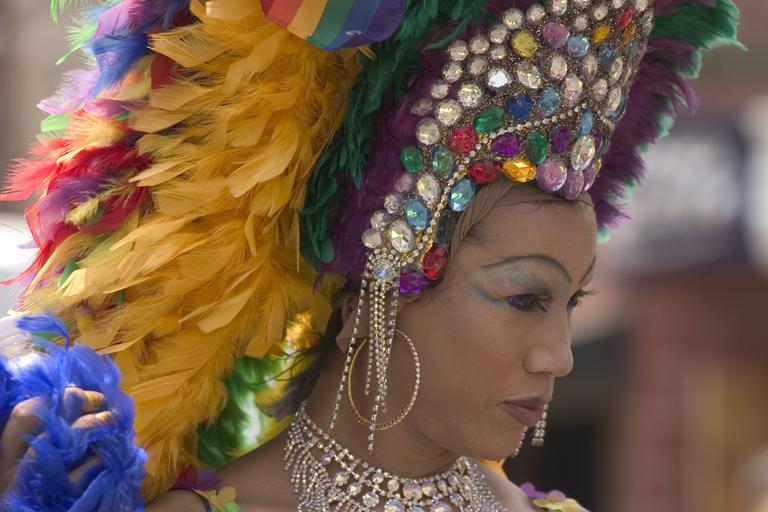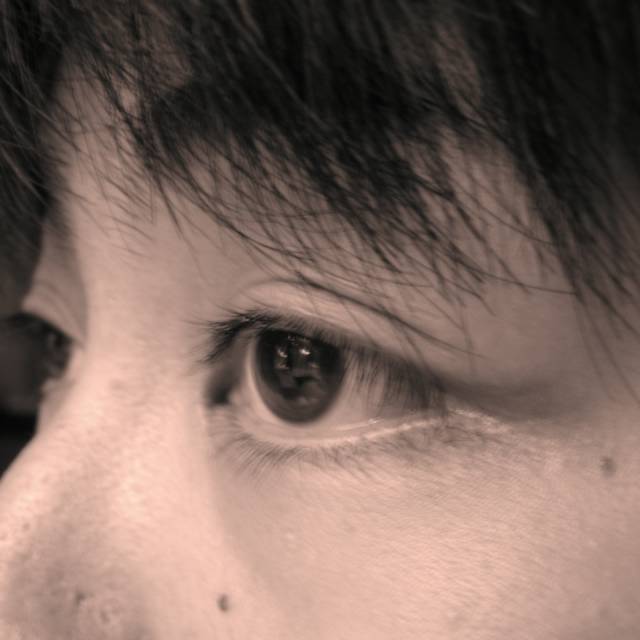beyond the four borders
She looks as if she has retreated into her own inner world, oblivious of the rambunctious festivity all around her. Her profile is frozen in this private moment, with her heavily made-up face slightly tilted, her dark eyes cast down pensively. There is an expression on her face, of a person in touch with something intangible, of a woman lovingly holding something fragile so dear to her. On her head is a headdress of rainbow feathers and colorful fake crystals the size of her eyes. She has a hand raised at her shoulder, lightly holding the blue feathers trailing down from her exuberant headdress. Yellow nail enamel on the tips of her fingers is visible on the blue feathers, like a few precious eggs of a tiny bird in a blue nest. The crystals and line stones that hang from her ears and circle around her neck sparkle, reflecting the mid-morning sun of June. Under the heavy makeup and dazzling costume of a samba dancer, I cannot tell if she is really a woman.
One Sunday in June 2005, I decided to hunt for opportunities for candid portraiture in the Gay Pride Parade of Chicago. Earlier in the year, I had surprised myself with a few gripping portraits I took during the Cinco de Mayo Parade in Pilsen. I itched for more such opportunities. I borrowed Patrick’s Canon, a reliable SLR (single lens reflex) camera, a 50 mm lens and a 70-200 zoom, and hopped on the red line. As the red line train moseyed toward Belmont, it became decidedly festive with a drove of men in shiny drag and crazy hand-made costumes got on at each station. A sense of strange camaraderie brewed in the train, although no one openly made a cheering racket.
At Addison, a silver-painted man with a gigantic pair of white wings came in, with his three servants in flashy blue Teutonic armors and matching helmets. The winged man majestically smiled and nodded at the passengers, who admired his elaborate costume. But my eyes were nailed to three conspicuous bulges in the fronts of the Teutonic men: their armors stopped abruptly at their bellies, and all they had underneath them were tiny, tight-fit triangles of swimsuits, from where their blue legs stretched into their blue flip-flops. Oh, boy, I thought. How many of these protrusions am I going to see today? Patrick had told me that people “can go quite far” in the event. I felt a liberal half of me struggling against the other, more prudish half of me as to the appropriateness of the open display of sexuality in public. As much as I embraced the honest talk about sexuality and equal treatment of various sexualities, I felt at a loss at the sight of its ostentatious display. Yet, if the whole purpose of the Gay Pride Parade was to celebrate the gay sexuality, along with the gay experience, my discomfort with the conspicuous blue bulges seemed to have no space in the occasion. At least I have someone not too hard to follow now, I thought, peeling off my eyes from the Teutonic soldiers.
As I turned the matter this way and that way in my mind, the L arrived at Belmont. I got off the train, following our majestic silver angel. As he inched toward the exit on the crowded platform, the silver angle sprinkled his theatrical smile liberally upon spectators and fellow participants of the parade. I noticed stubs of beard on his round chin. He and his Teutonic blue men led the obedient herd to the intersection of Clark and Belmont. Some of the spectators bought cheap metallic rainbow beads and small rainbow flags from street vendors as we passed them by. TV crews were busily setting up their threatening cameras on tall cranes hovering over the street, while a few young women took off their punk tee-shirts and crossed off each others’ nipples from their breasts using strips of gray duct tape, as if they were tearing delicate handles off translucent bone china teacups. Dozens of exuberant men and women self-consciously adjusted their costumes on the colorful stages set on trucks. A gigantic pink flamingo with a tall bobbing head chatted away with an Andalusian widow in a black shawl and an elaborately carved comb, waiting for the parade to start moving. I pulled out the Canon and took some general shots, hesitant to zero-in to the men in opulent costume on stages and on the pedestrian street. I felt a kind of thin curtain of instinctive defensiveness and rigidity descend on the parade participants at the moment they noticed my camera.
I started walking down the Clark Street, looking for a good subject, preferably someone engrossed in his own concern, unconscious of the surroundings. I switched the 50 mm lens with the 70-200 that would allow me to get intimate shots without getting too close to the subjects. I didn’t want them to notice me partially because I was too shy to talk to them. The biggest reason, however, was to capture the natural expression of the people, avoiding the artificiality of posed portraits. Gradually the festive atmosphere of the parade seeped through my timid skin, making me feel open and bold. I started to shoot bursts of colors on men in drag, confidence in gay men feeling comfortable in their own skins, coquetries of dark-skinned female dancers dressed like hyper-sexual orange cats, and occasional insecurity of the parade participants betrayed through their excessive display of pride and confidence. Some of them noticed me and my conspicuously long zoom lens. As the enthusiasm of the parade seized them one by one, just as it did me, more and more of them winked, smiled, and waved at me. Soon I found myself smiling back and waving my camera in thankful gesture. I wasn’t a part of the parade, that was for sure. With my invasive and patronizing gaze through my camera, I was a conscious outsider. Yet, the welcoming gestures of the “true” participants, which in themselves were a product of the communal enthusiasm, had a gradual but palpable blurring effect on the boundary.
About fifty shots later, I came across a group of samba dancers waiting for the parade to move on. At first, my eyes were fixed on a smallish but energetic African American woman, who literally jumped around the group in a burst of rage. I tried to capture her naked and sincere anger, so rare to see in our emotionally well-insulated lives. In her rage, she bared her teeth, glared at a member of her group, shouting something that was lost in the cheerful noise of the crowd before it reached me. Before long, however, I gave up on capturing her. Along with the difficulty of following her as she quickly disappeared to and reappeared from behind the wall of colorful dancers, a doubt as to the morality of photographing someone’s emotional explosion without her permission held me back. The age-old stereotype of Africans as primitive, emotional and savage immediately came to mind—would I be reinforcing the stereotype by visually reproducing the image? I didn’t feel that I had a convincing answer that could justify my photographing her emotional moment if the dancer were to confront me on the ethics of the action.
Leaving the angered dancer in a golden headdress, I looked around for another subject. A few feet away from the main group, I found a quiet Caucasian dancer who seemed to be oblivious of the intense scene taking place only a few steps from her. She seemed to be absorbed in her own private thoughts, intense and sincere in its own way. I pointed the camera at her, framed out everything except for her profile and her gorgeous headdress of trailing feathers and glittering crystals, adjusted the exposure, and released the shutter several times in a row. The small mirror in the camera made the familiar clicking sounds.
When I removed the camera from my eye, the African American woman was nowhere to be seen. I probably took fifty more shots as the day and the parade proceeded, but when I looked at the photographs I took on that day, the shot of the pensive dancer surpassed all the rest. With the quiet but intense emotion on her face and inexhaustible details of her headdress, it is visually captivating. Yet, the photograph bears a special meaning to me precisely because of what are not in the frame. The photograph preserves what I did not photograph: the blue conspicuous bulges of the Teutonic warriors, the taped-off pale breasts of young women, and the bared teeth of the samba dancer. In future, as I mature as a photographer and come to terms with ethics and emotions involved in the art, I will probably look back at the photograph and trace the meandering route I have taken to reach the position I have come to embrace. But now, the photograph of the pensive samba dancer is a portal to the myriad unsolved questions that lie beyond its four borders.

keywords: photography, portrait, candid, Gay Pride Parade, Chicago Gay Pride Parade, LGBT, ethics, 2005, festival, parade, ethics of photography



0 Comments:
Post a Comment
<< Home